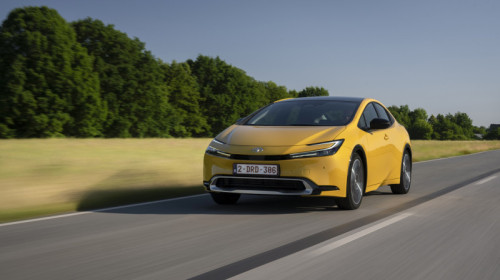
New Toyota Prius Plug-in Hybrid offers innovative design
The Toyota Prius offers the unexpected for its fifth generation, with a stunning new chapter in the story of engineering innovation and dynamic design. Dubbed the Prius Plug-in Hybrid in Europe, only available in Europe as the Plug-in Hybrid Electric, the latest Prius defies convention once again, following the trailblazing wheel tracks of its famous predecessors. For more than a quarter of a century, the Prius has made a lasting impact as the first mass-produced electric vehicle in Toyota and the world, setting future EV trends and making electric technology accessible to a wide range of customers.
The latest Prius takes the next step in that journey by introducing the enhanced electrification of the latest Plug-in Hybrid Electric (PHEV) technology to compliment Toyota’s multi-path approach to carbon neutrality which has already seen sales of more than 23 million electrified vehicles globally, with the Hybrid and Plug-in Hybrid versions of Prius alone accounting for more than 5 million units.

Dedicated to providing low carbon solutions
Toyota is committed to offering low-carbon solutions for all its customers, according to their local needs and infrastructure to ensure no driver is left behind on the road to carbon neutrality. As its most powerful and efficient PHEV, the new Prius strengthens Toyota’s line-up, which includes a commitment to battery electric (BEV) and fuel cell electric (FCEV) vehicles to offer customers a wider range of carbon reduction options.
A combination of true electric vehicle (EV) performance and all the convenience of the latest Hybrid technology delivers a dual DNA at the heart of the new Prius Plug-in Hybrid. Up to 86 km EV driving range from its 13.6 kWh battery allows fully electric driving on most daily journeys. For longer journeys, or when charging is not practical, Toyota’s new generation Plug-in Hybrid system has enhanced output and an ultra-low combined WLTP CO2 emissions rating of 11 g/km – the lowest ever for a Prius.
Since its launch in 1997, the Prius has been heralded for efficiency but not necessarily performance. However Toyota’s fifth generation hybrid technology has the power to surprise. The hybrid system delivers an overall improvement to the driving experience, providing more power and greater efficiency. The TNGA 2.0 litre engine produces 152 DIN hp (112 kW) and works in tandem with a new 163 DIN hp (120 kW) transaxle front motor for a total system output of 223 DIN hp (164 kW). Compared to the previous generation’s 122 DIN hp (90 kW) in Plug-in Hybrid configuration, the increased output ensures strong and responsive acceleration.
The hybrid system provides more power and greater efficiency
Fun to drive with the latest Prius goes beyond its unexpected power and acceleration. Balance and handling have also been enhanced, thanks to the second-generation GA-C platform of the Toyota New Global Architecture (TNGA) which brings lower weight and higher rigidity for a more stable ride. A lower centre of gravity, achieved by placing the EV battery under the rear seat and moving the fuel tank lower and more forward compared to the previous generation, contributes to enhanced driving dynamics and agility.
In the quest for maximum efficiency, up to 8.7 kilometres of EV range a day (based on annual sunlight in Nagoya, Japan) can be generated by optional solar cells integrated in the roof. These now charge the plug-in hybrid battery directly, without the need for an additional solar battery as on previous models. The roof is smaller than before, but thanks to new solar cells, the overall efficiency is improved by more than 15 %.
Although the Prius has always had an eye-catching appearance, the latest generation is surprisingly stylish. The iconic wedge shape, a Prius original since the second generation, has evolved, embracing elegant modern lines. A coupé-like silhouette has been created by lowering the overall height by 50 mm, moving the roof peak rearwards and adopting larger diameter tyres, up to 19 inches.

